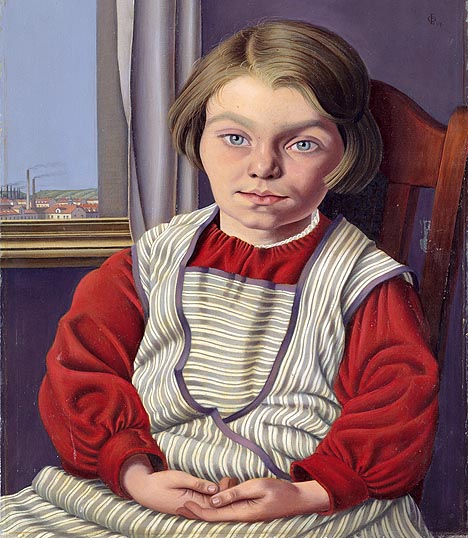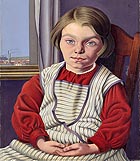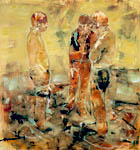
translated and summarized by: Liz Wollner-Grandville,
english summaries October 17 - 31
Staatliche Kunstsammlungen Dresden
New Objectivity in Dresden. Paintings of the 1920’s from Dix to Querner
01.10.11 – 08.01.12
Objective between left and right
Kokoschka was here - he had only just recovered from his severe injuries and was still traumatized by his experience at the frontlines at Isonzo. The former Viennese Enfant Terrible – in panic at the thought of possibly being drafted again – travelled to Dresden via Berlin in 1916, hoping to stay and become professor at the Art Academy. In 1919 he was finally appointed – and the Master’s lectures on the “Abendakt”, the evening drawing classes, were extremely popular - mainly due to his amusing outbursts of rage.
While Kokoschka invented a new method of applying paint by mixing the colours directly on the canvas with fig milk to attain a moving structure, a group of war veterans, who had returned home from the horrors they experienced, formed a new artists' movement. They were united in their attitude that it was impossible to continue working as usual after the atrocities they had experienced. In 1905, Expressionism was practically no longer existent in Dresden and Dadaism seemed a short-lived satisfaction for the progressive and politically committed young men. One of them, Otto Dix, later said the artists wanted to “see things very closely, almost without art.” The works by Dix and his colleagues, including Otto Griebel and Conrad Felixmüller, came across as cynical and shocking; and they often used painting techniques employed by the Old Masters. Their works depicted the reality of hunger, unemployment and prostitution.
“New Objectivitiy”, was a term created by Gustav Hartlaub for an exhibition in 1925. Despite differentiating between the critical “Verists” and the more classicistic “right wing” or “magic realism” the term was unable to encompass all positions. Undoubtedly Dresden played an important role in this development but a scientific reappraisal was only possible after the German Unification. And this is the outcome of this exhibition curated by Birgit Dalbajewa, including the accompanying catalogue.
Possibly this was the missing part for an extensive presentation of the phenomenon “New Objectivity”, which mirrors more of a life feeling, an attitude than a stylistic feature. And that reveals the actual dilemma: while the National Socialists prohibited Dix and his colleagues to paint, the right wing group was permitted to continue their work. After the founding of the GDR this art continued to be collected and new objectivity was now seen as socialist realism. It could well be that one or the other of the 80 artistic positions presented here are only interesting for the market owing to the intensive reappraisal, but by contrast, the scientific work is of immeasurable value for the overall image of New Objectivity in Germany.
By Daniela Gregori
Staatliche Kunstsammlungen Dresden
01067 Dresden, Taschenberg 2
Tel: +49 (0)351 49 14 2000
Fax: +49 (0)351 49 14 2001
Email: info@skd-dresden.de
www.skd.museum
Opening Hours: Mon – Fri 8 – 18 hours, Sat, Sun 10 – 18 hours
Startgalerie im MUSA
Brigitte Kovacs – Musenanruf
14.10.11 – 05.11.11
When the muse allows itself to be kissed
Even if muses, according to the original ancient Greek concept, are not of this world, today’s generally accepted interpretation is that of a person who inspires or motivates others - mainly artists - to develop something creative. Modern muses are no longer mythical figures but people in close contact with artists whose inspirational power evolves through their interpersonal relationship. Yet the perception of a muse remains extremely vague – the“muse’s kiss” being the Greek mythological interpretation of its appearance.
Brigitte Kovats, on the other hand, interprets the phrase being “kissed by the muse” literally and presents photos showing her being kissed by a variety of different muses – all chosen by her. Her muses are far from being romantic figures but rather key figures of the Viennese art scene – and that clearly questions to which extent our romantic-creative imagination of art ignores sober reality. Do today’s muses achieve something simply by knowing the right people instead of breathing life into creativity? Next to the photos, Kovacs displayed the letters of refusals that she had received. And here again the various definitions of the term "muse" become apparent - with the predominant question being if one is actually suitable to be considered a muse in the first place.
The photo series develop a kind of poetic power and partly come across as dreamy, thereby proving that art is obviously unable to exist without at least a breath of romanticism. And therefore it doesn’t come as a surprise that the muse is being kissed rather than vice versa, the selected muses could actually be thankful that hey have been chosen by the artist. But it remains to be answered if something like a creative spark evolved.
By Wolfgang Pichler
Startgalerie im MUSA
1010 Vienna, Felderstrasse 6-8, next to the town hall
Tel: +43 (0) 1 4000 8400
Email: musa@musa.at
www.musa.at/startgalerie
Opening hours: Tue, Wed, Fri: 11 – 18 hours, Thu: 11 – 20 hours, Sat 11 – 16 hours
Kunstverein das weisse haus
AVPD: Weiss; Tatiana Lecomte; Jakob Neulinger – Reception Room
28.09.11 – 03.12.11
Park profoundly programmatically
Art is not a lady that comes around for a visit. In general, one would have to visit her and one probably won’t even be offered a seat. The word “TRUST”, is written on the wall adjoining the parking lot in front of the Weisse Haus in white letters on a blue background (Gerhard Himmer).
On the second floor, a door opens to a narrow and artificially lit office corridor. In the room to the left (Project Room with Jakob Neulinger’s “Reception Room”, to be seen until 17 November 2011) there is a brass-coloured tube guiding system spanned from floor to ceiling and next to it is the three-part brand of an automobile manufacturer with a double-coloured granite cover. An unfriendly looking stuffed owl is sitting on a dry twig in a corner.
A corridor, flanked by video projections featuring interviews with artists, leads to a variety of rooms showing colour photographs all depicting a happy woman, which are hung next to black-and-white photos of the Führer (Tatiana Lecomte). The vast majority of these photos originate from an archive found on the street. Most of the photos show a woman in a large variety of poses; the shots were taken over the course of many decades and she obviously had an unburdened relationship with the photographer. Positioned between the woman’s photos are pictures of the Führer driving an automobile. This juxtaposition is consciously arranged with a certain degree of obscenity, and anyone who doesn’t like encountering obscenities, has every reason to be angry.
A room with four rectangular curtain tracks with light and gleaming white cloth curtains hanging from them is transformed into a body-reflecting chamber of veils. (Danish artist duo AVPD). One can take another door out of the labyrinth and find oneself on the other side of an electro chromatic window, shimmering as if a mirror or frosted glass. Furthermore, there are numerous drawings and light projections created by the Danish artist duo as well as a light installation (Corinne L. Rusch).
Art is not a distinguished lady that calls in for a visit and a chat. Art is more like a gym teacher with a harsh voice, persistently summoning us to practice our senses and to give sense a new perspective. When she says: “TRUST” one can ask her why she is speaking English. And she is generous and allows us to come up with an answer.
By Gesche Heumann
Kunstverein das weisse haus
1050 Vienna, Geigergasse 5-9, 2.Floor
www.dasweissehaus.at
Opening hours: Tue – Fri 15 – 20 hours, Sat 12 – 17 hours
Galerie Gerersdorfer
Robert Muntean – All that could have been
22.10.11 – 12.11.11
People who look good in paintings
Francis Bacon had a particular affinity to alcohol - his chaotic studio was covered in dust and dirt and he painted people, whose faces and bodies were composed of dizzying and brittle streaks, thereby creating sad and deformed pictures.
Robert Muntean’s small-format portrait of Francis Bacon (30x40, oil, 2011) shows Bacon’s glance as being either blasé and curious, or sad and amused. Muntean paints the reflection of light on Bacon’s face with a harsh yellow tone, the shadows consist of apparently random pink-black brushstrokes and a light dusky-pink splash – the shadow on the yellow splash hides nothing and presents his right eyebrow exactly where it is supposed to be. This is the smallest of the nearly 20 works shown in the exhibition that was sold out before it opened. Numerous paintings of people are shown combined with a picture of a fox or a horse, primarily in earth-coloured warm tones. The pictures of people depict individuals and groups: three men in a clearing talking to each other (All that could have been, 150x140, oil, 2011), two men looking down into a canyon with a reddish-white spot (“The great below”, 150x140, oil, 2011), a man placing his hand on another’s’ shoulder (Trask”, 110x105, oil, 2011). The figures only consist of a few lines and structures of light. The fore- and backgrounds are separated. The spontaneous background contrasts with the immersion and concentration of the figures among one another. It is less as if there was something dangerous looming beneath what is visible, but more that what is visible emerges with dreamlike-energy from what is beneath.
Muntean invests a lot of time in his individual brushstrokes thus allowing the painting to emerge and thereby perfectly balancing the composition of the group pictures. The scenes don’t appear dramatic or odd or historic, bur rather familiar and incidental. The bucolic procedure of the works pleasantly reminds of Siegfried Anzinger. Robert Muntean’s pictures of people, compared to those by other artists, has the encouraging forward-looking characteristic that one would trust most people in Muntean’s paintings to have something in common and something profoundly peaceful: when viewing the paintings, one could wish to be part of this atmosphere.
By Gesche Heumann
Galerie Gerersdorfer
1090 Vienna, Währinger Strasse 12
Tel: +43 (0) 1 310 84 84
Fax: +43 (0) 1 310 84 85
email: office@gerersdorfer.at
www.kunstnet.at/gerersdorfer
Opening hours: Thu, Fri, Sat 11 - 20 hours
Mehr Texte von translated and summarized by: Liz Wollner-Grandville


 Teilen
Teilen





